Page 343 of 5135
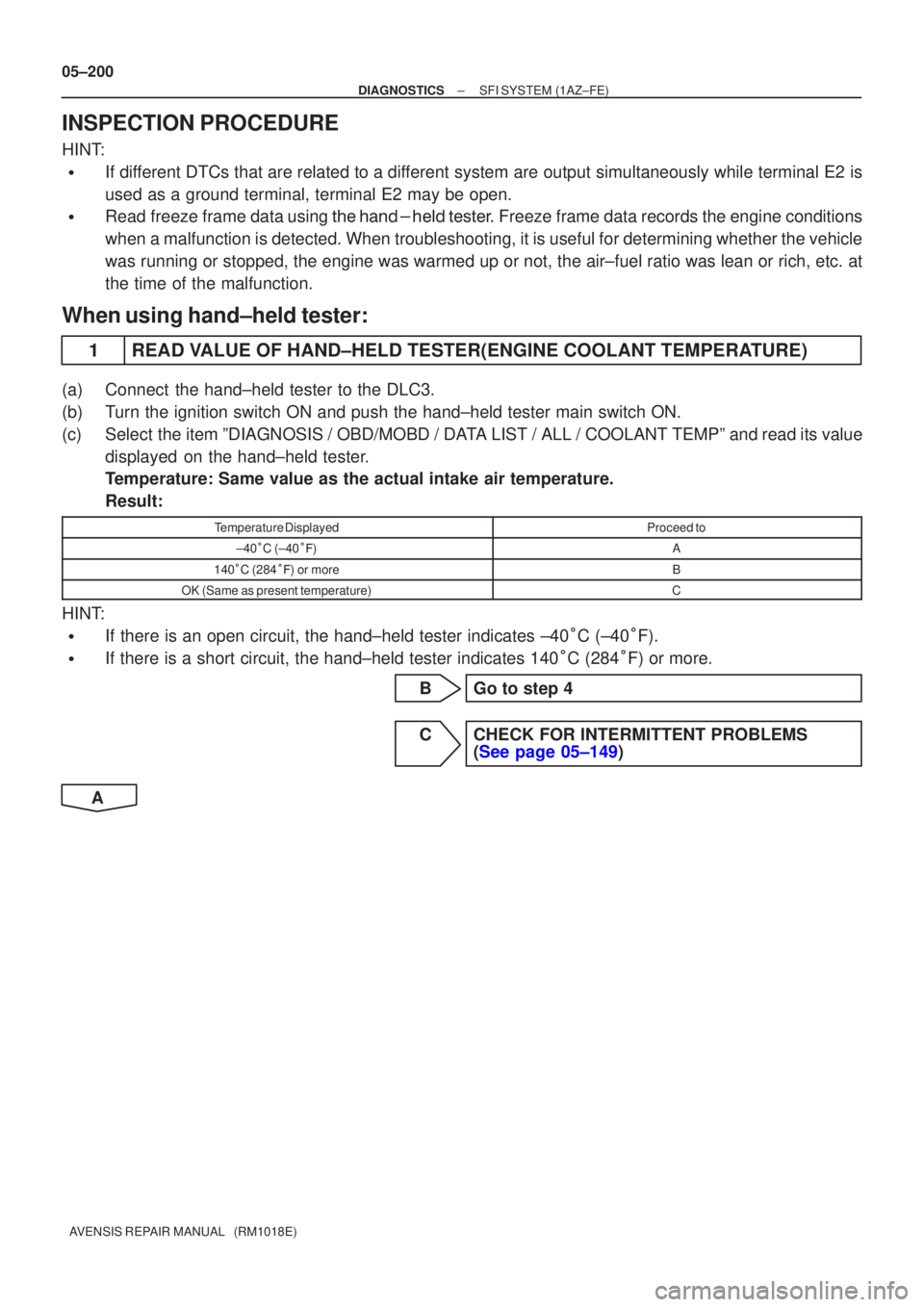
05±200
±
DIAGNOSTICS SFI SYSTEM(1AZ±FE)
AVENSIS REPAIR MANUAL (RM1018E)
INSPECTION PROCEDURE
HINT:
�If different DTCs that are related to a different system are output simultaneously while terminal E2 is
used as a ground terminal, terminal E2 may be open.
�Read freeze frame data using
\b�\b�
��\b� �
�\f
��� Freeze frame data records the engine conditions
when a malfunction is detected. When troubleshooting, it is useful for d\
etermining whether the vehicle
was running or stopped, the engine was warmed up or not, the air±fuel ra\
tio was lean or rich, etc. at
the time of the malfunction.
When using hand±held tester:
1READ VALUE OF HAND±HELD TESTER(ENGINE COOLANT TEMPERATURE)
(a)Connect the hand±held tester to the DLC3.
(b)Turn the ignition switch ON and push the hand±held tester main switch \
ON.
(c)Select the item ºDIAGNOSIS / OBD/MOBD / DATA LIST / ALL / COOLANT TEMPº and read its value displayed on the hand±held tester.
Temperature: Same value as the actual intake air temperature.
Result:
Temperature DisplayedProceed to
±40�C (±40 ��)A
140 �C (284 ��) or moreB
OK (Same as present temperature)C
HINT:
�If there is an open circuit, the hand±held tester indicates ±40 �C (±40 �F).
�If there is a short circuit, the hand±held tester indicates 140 �C (284 �F) or more.
BGo to step 4
CCHECK FOR INTERMITTENT PROBLEMS (See page 05±149)
A
Page 347 of 5135

± 20 0 20 40 60 80 100
(± 4) 32 68 104 140 176 212 30
20
10
5
3
2
1
0.5
0.3
0.2
0.1
A67628
Acceptable (Fig.1)
Resistance K�
Temp. �C (�F)
05±194
± DIAGNOSTICSSFI SYSTEM (1AZ±FE)
AVENSIS REPAIR MANUAL (RM1018E)
DTC P0110/24 INTAKE AIR TEMPERATURE CIRCUIT
MALFUNCTION
DTC P0112/24 INTAKE AIR TEMPERATURE CIRCUIT LOW
INPUT
DTC P0113/24 INTAKE AIR TEMPERATURE CIRCUIT HIGH
INPUT
CIRCUIT DESCRIPTION
The intake air temperature sensor is built in the mass air flow
meter and senses the intake air temperature.
A thermistor built in the sensor changes the resistance value
according to the intake air temperature.
The lower the intake air temperature is the greater the thermis-
tor resistance value becomes and the higher the intake air tem-
perature is the lower the thermistor resistance value becomes
(See Fig. 1).
The intake air temperature sensor is connected to the ECM
(See below ). The 5 V power source voltage in the ECM is ap-
plied to the intake air temperature sensor from terminal THA
(THAR) via resistor R.
That is, the resistor R and the intake air temperature sensor are
connected in series. When the resistance value of the intake air
temperature sensor changes in accordance with changes in the
intake air temperature, the potential at terminal THA (THAR)
also changes. Based on this signal, the ECM increases the fuel
injection volume to improve the driveability during cold engine
operation.
DTC No.Proceed toDTC Detection ConditionTrouble Area
P0110/24Step 1
Open or short in intake air
temp. sensor circuit for 0.5
sec.
�Open or short in intake air temperature sensor circuit
P0112/24Step 4Short in intake air temp. sen-
sor circuit for 0.5 sec.
�Oen or short in intake air tem erature sensor circuit
�Intake air temperature sensor (built in mass air flow meter)
�ECM
P0113/24Step 2Open in intake air temp. sen-
sor circuit for 0.5 sec.
After confirming DTC ºP0110/24, P0112/24 or P0113/24º, use the hand±held tester to confirm the intake air
temperature from the ºDIAGNOSIS / OBD/MOBD / DATA LIST / ALLº.
Temperature DisplayedMalfunction
±40�C (±40���Open circuit
140�C (284��� �� ����Short circuit
05C7G±01
Page 348 of 5135
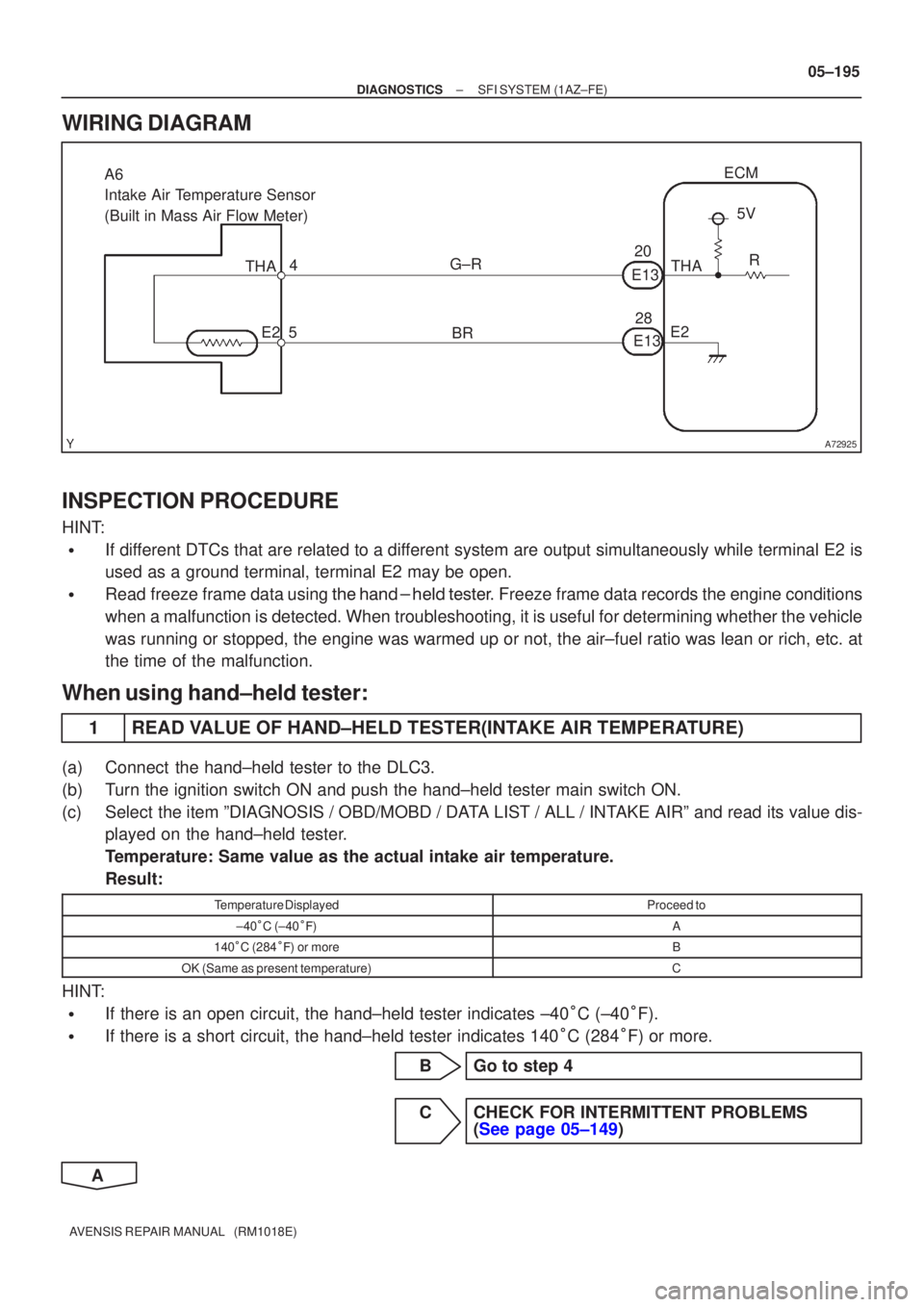
A72925
BR
G±R
28
20
E13 THA
E2 ECM
5 4
A6
Intake Air Temperature Sensor
(Built in Mass Air Flow Meter)
E135V
R
THA
E2
±
DIAGNOSTICS SFI SYSTEM(1AZ±FE)
05±195
AVENSIS REPAIR MANUAL (RM1018E)
WIRING DIAGRAM
INSPECTION PROCEDURE
HINT:
�If different DTCs that are related to a different system are output simultaneously while terminal E2 is
used as a ground terminal, terminal E2 may be open.
�Read freeze frame data using
\b�\b�
��\b� �
�\f
��� Freeze frame data records the engine conditions
when a malfunction is detected. When troubleshooting, it is useful for d\
etermining whether the vehicle
was running or stopped, the engine was warmed up or not, the air±fuel ra\
tio was lean or rich, etc. at
the time of the malfunction.
When using hand±held tester:
1READ VALUE OF HAND±HELD TESTER(INTAKE AIR TEMPERATURE)
(a)Connect the hand±held tester to the DLC3.
(b)Turn the ignition switch ON and push the hand±held tester main switch \
ON.
(c)Select the item ºDIAGNOSIS / OBD/MOBD / DATA LIST / ALL / INTAKE AIRº and read its value dis- played on the hand±held tester.
Temperature: Same value as the actual intake air temperature.
Result:
Temperature DisplayedProceed to
±40�C (±40 ��)A
140 �C (284 ��) or moreB
OK (Same as present temperature)C
HINT:
�If there is an open circuit, the hand±held tester indicates ±40 �C (±40 �F).
�If there is a short circuit, the hand±held tester indicates 140 �C (284 �F) or more.
BGo to step 4
CCHECK FOR INTERMITTENT PROBLEMS (See page 05±149)
A
Page 353 of 5135
A76863
B±Y
Battery FL MAINEngine Room R/B No. 4
G EFI Relay
A6
Mass Air Flow MeterMREL
B±G 4B 1
W±BB±W 53
2
1
32
E128
E9ECM
EFI No. 1
EC 4A 1
Engine Room
J/B No. 4 1A 1
B±G 1 2
EFI 1
Engine Room
R/B No. 1 and
Engine Room
J/B No.14
4
44
4
4
2
1 W±B
B±R
B±RGR
GRIE1 2
EVG 24
E12VG
L±Y 1
3
2 EA112
± DIAGNOSTICSSFI SYSTEM (1AZ±FE)
05±187
AVENSIS REPAIR MANUAL (RM1018E)
WIRING DIAGRAM
INSPECTION PROCEDURE
HINT:
Read freeze frame data using the hand±held tester. Freeze frame data records the engine conditions when
a malfunction is detected. When troubleshooting, it is useful for determining whether the vehicle was running
or stopped, the engine was warmed up or not, the air±fuel ratio was lean or rich, etc. at the time of the mal-
function.
Page 360 of 5135
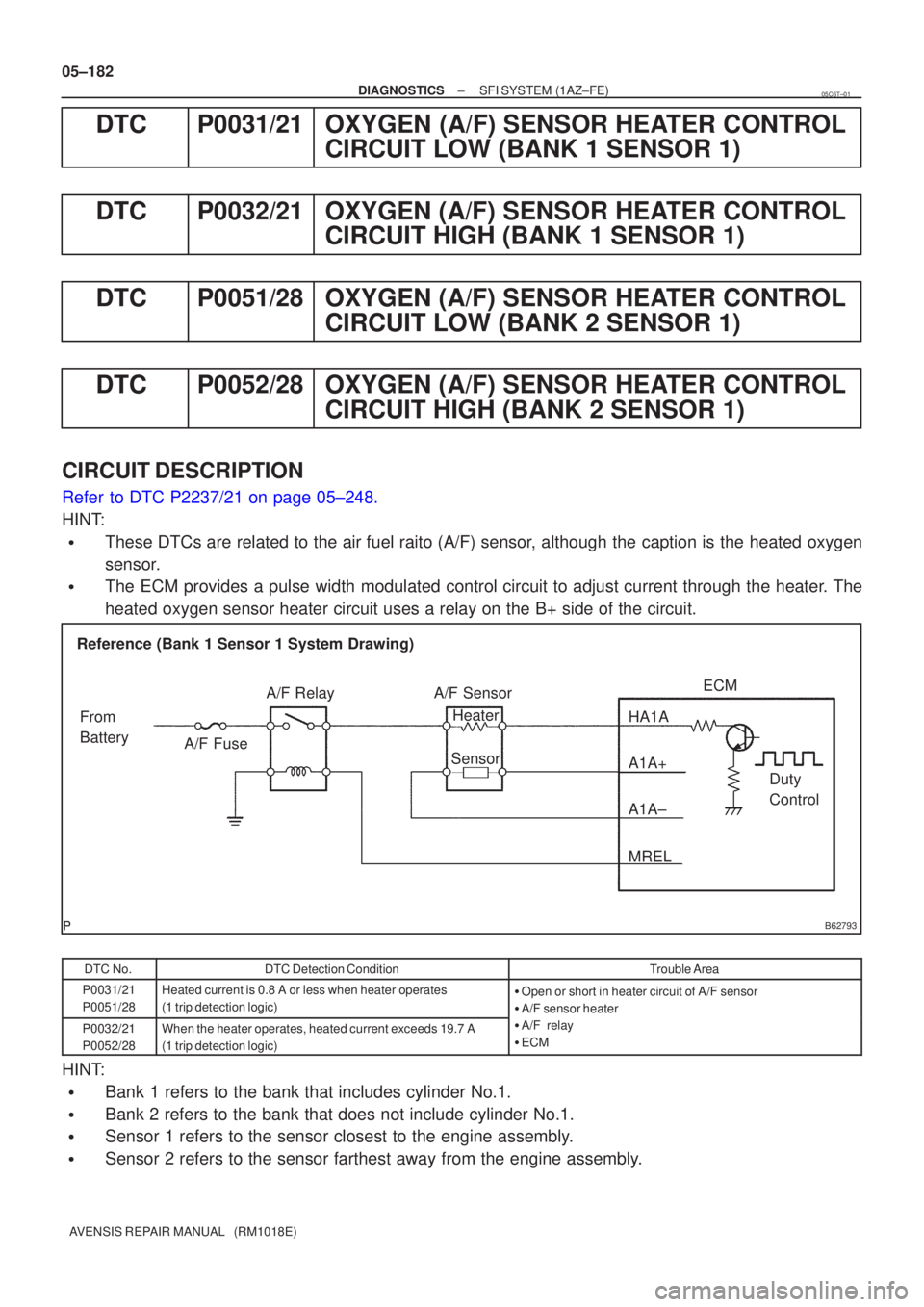
B62793
Reference (Bank 1 Sensor 1 System Drawing)A/F Sensor
A/F Relay
Heater
Sensor A1A+ HA1A
Duty
Control
ECM
From
Battery A/F Fuse
A1A±
MREL
05±182
±
DIAGNOSTICS SFI SYSTEM(1AZ±FE)
AVENSIS REPAIR MANUAL (RM1018E)
DTCP0031/21OXYGEN (A/F) SENSOR HEATER CONTROL CIRCUIT LOW (BANK 1 SENSOR 1)
DTCP0032/21OXYGEN (A/F) SENSOR HEATER CONTROL CIRCUIT HIGH (BANK 1 SENSOR 1)
DTCP0051/28OXYGEN (A/F) SENSOR HEATER CONTROL CIRCUIT LOW (BANK 2 SENSOR 1)
DTCP0052/28OXYGEN (A/F) SENSOR HEATER CONTROL CIRCUIT HIGH (BANK 2 SENSOR 1)
CIRCUIT DESCRIPTION
Refer to DTC P2237/21 on page 05±248.
HINT:
�These DTCs are related to the air fuel raito (A/F) sensor, although the caption is the heated oxygen
sensor.
�The ECM provides a pulse width modulated control circuit to adjust curre\
nt through the heater. The
heated oxygen sensor heater circuit uses a relay on the B+ side of the c\
ircuit.
DTC No.DTC Detection ConditionTrouble Area
P0031/21
P0051/28Heated current is 0.8 A or less when heater operates
(1 trip detection logic)�Open or short in heater circuit of A/F sensor
� A/F sensor heater
P0032/21
P0052/28When the heater operates, heated current exceeds 19.7 A
(1 trip detection logic)�A/F relay
� ECM
HINT:
�Bank 1 refers to the bank that includes cylinder No.1.
�Bank 2 refers to the bank that does not include cylinder No.1.
�Sensor 1 refers to the sensor closest to the engine assembly.
�Sensor 2 refers to the sensor farthest away from the engine assembly.
05C6T±01
Page 361 of 5135
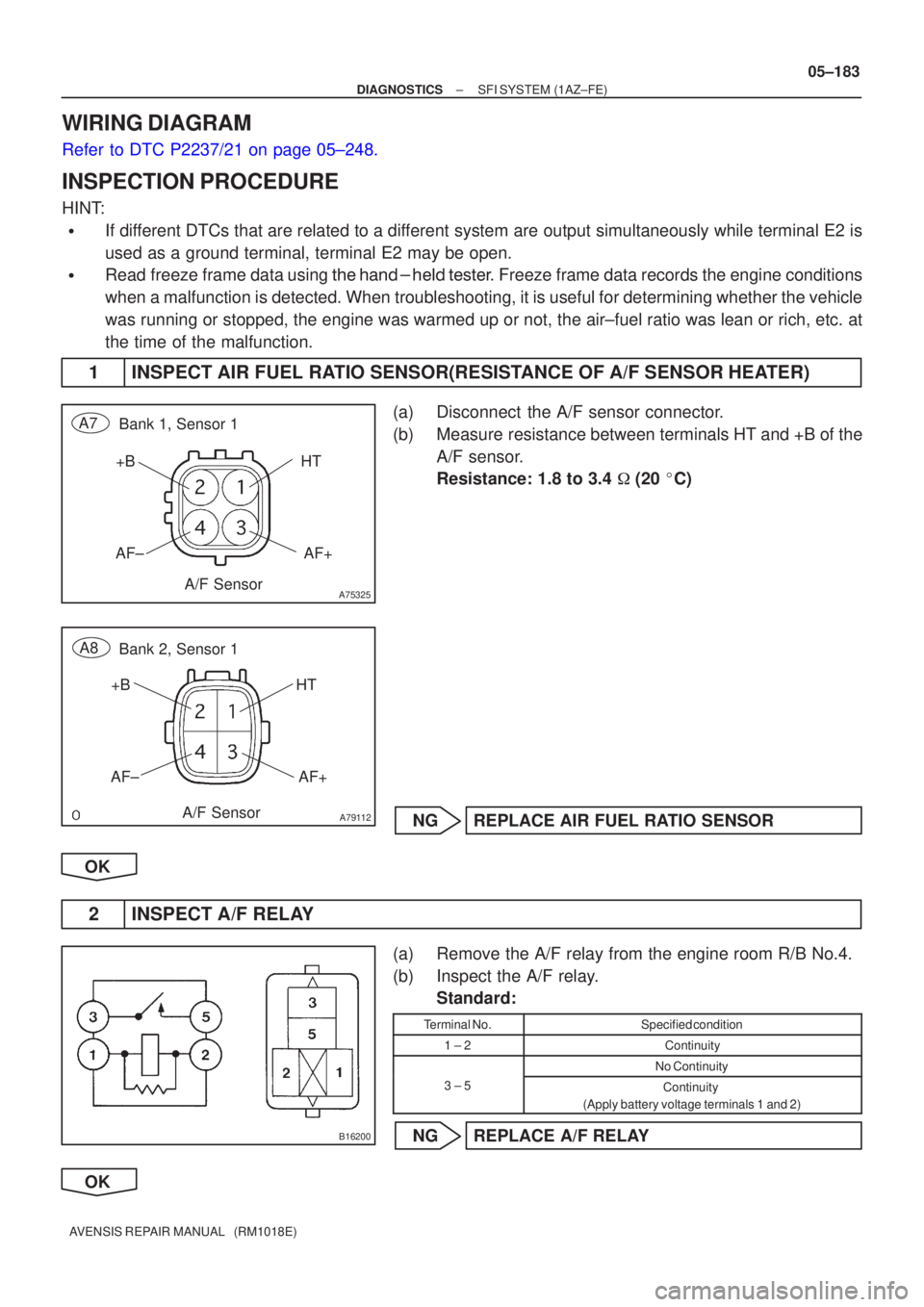
A75325
HTAF+
+B
AF±
Bank 1, Sensor 1
A7
A/F Sensor
A79112
Bank 2, Sensor 1
A8
A/F Sensor HT
AF+
+B
AF±
B16200
±
DIAGNOSTICS SFI SYSTEM(1AZ±FE)
05±183
AVENSIS REPAIR MANUAL (RM1018E)
WIRING DIAGRAM
Refer to DTC P2237/21 on page 05±248.
INSPECTION PROCEDURE
HINT:
�If different DTCs that are related to a different system are output simultaneously while terminal E2 is
used as a ground terminal, terminal E2 may be open.
�Read freeze frame data using \f�� �� ����\b� \f��\f�
� Freeze frame data records the engine conditions
when a malfunction is detected. When troubleshooting, it is useful for d\
etermining whether the vehicle
was running or stopped, the engine was warmed up or not, the air±fuel ra\
tio was lean or rich, etc. at
the time of the malfunction.
1 INSPECT AIR FUEL RATIO SENSOR(RESISTANCE OF A/F SENSOR HEATER)
(a) Disconnect the A/F sensor connector.
(b) Measure resistance between terminals HT and +B of the A/F sensor.
Resistance: 1.8 to 3.4 � (20 �C)
NG REPLACE AIR FUEL RATIO SENSOR
OK
2 INSPECT A/F RELAY
(a) Remove the A/F relay from the engine room R/B No.4.
(b) Inspect the A/F relay. Standard:
Terminal No.Specified condition
1 ± 2Continuity
No Continuity
3 ± 5Continuity
(Apply battery voltage terminals 1 and 2)
NG REPLACE A/F RELAY
OK
Page 364 of 5135
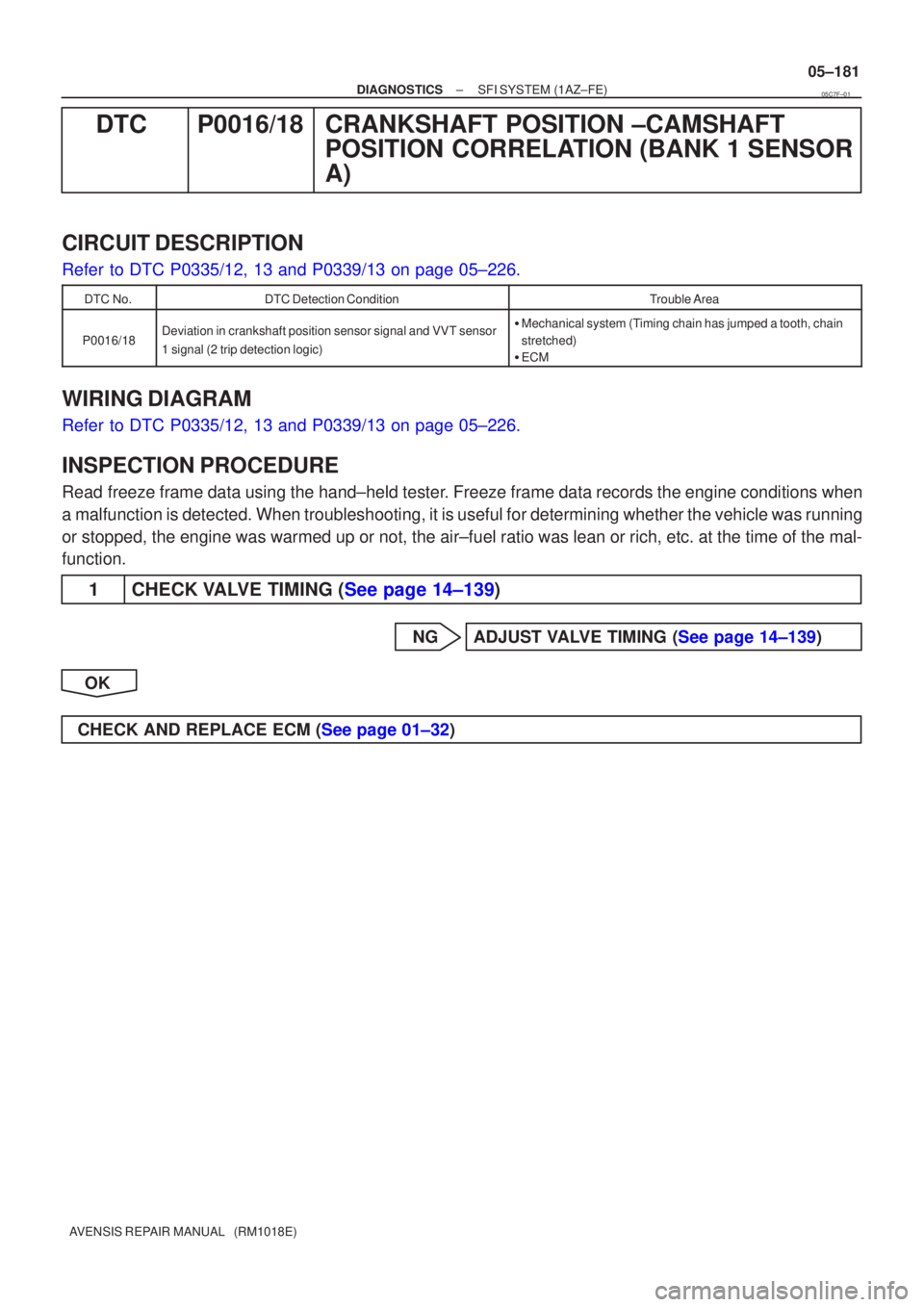
±
DIAGNOSTICS SFI SYSTEM(1AZ±FE)
05±181
AVENSIS REPAIR MANUAL (RM1018E)
DTCP0016/18CRANKSHAFT POSITION ±CAMSHAFT
POSITION CORRELATION (BANK 1 SENSOR
A)
CIRCUIT DESCRIPTION
Refer to DTC P0335/12, 13 and P0339/13 on page 05±226.
DTC No.DTC Detection ConditionTrouble Area
P0016/18Deviation in crankshaft position sensor signal and VVT sensor
1 signal (2 trip detection logic)�Mechanical system (Timing chain has jumped a tooth, chain
stretched)
� ECM
WIRING DIAGRAM
Refer to DTC P0335/12, 13 and P0339/13 on page 05±226.
INSPECTION PROCEDURE
Read freeze frame data using the hand±held tester. Freeze frame data records the engine conditions when
a malfunction is detected. When troubleshooting, it is useful for determi\
ning whether the vehicle was running
or stopped, the engine was warmed up or not, the air±fuel ratio was lea\
n or rich, etc. at the time of the mal-
function.
1CHECK VALVE TIMING (See page 14±139)
NGADJUST VALVE TIMING (See page 14±139)
OK
CHECK AND REPLACE ECM (See page 01±32)
05C7F±01
Page 365 of 5135
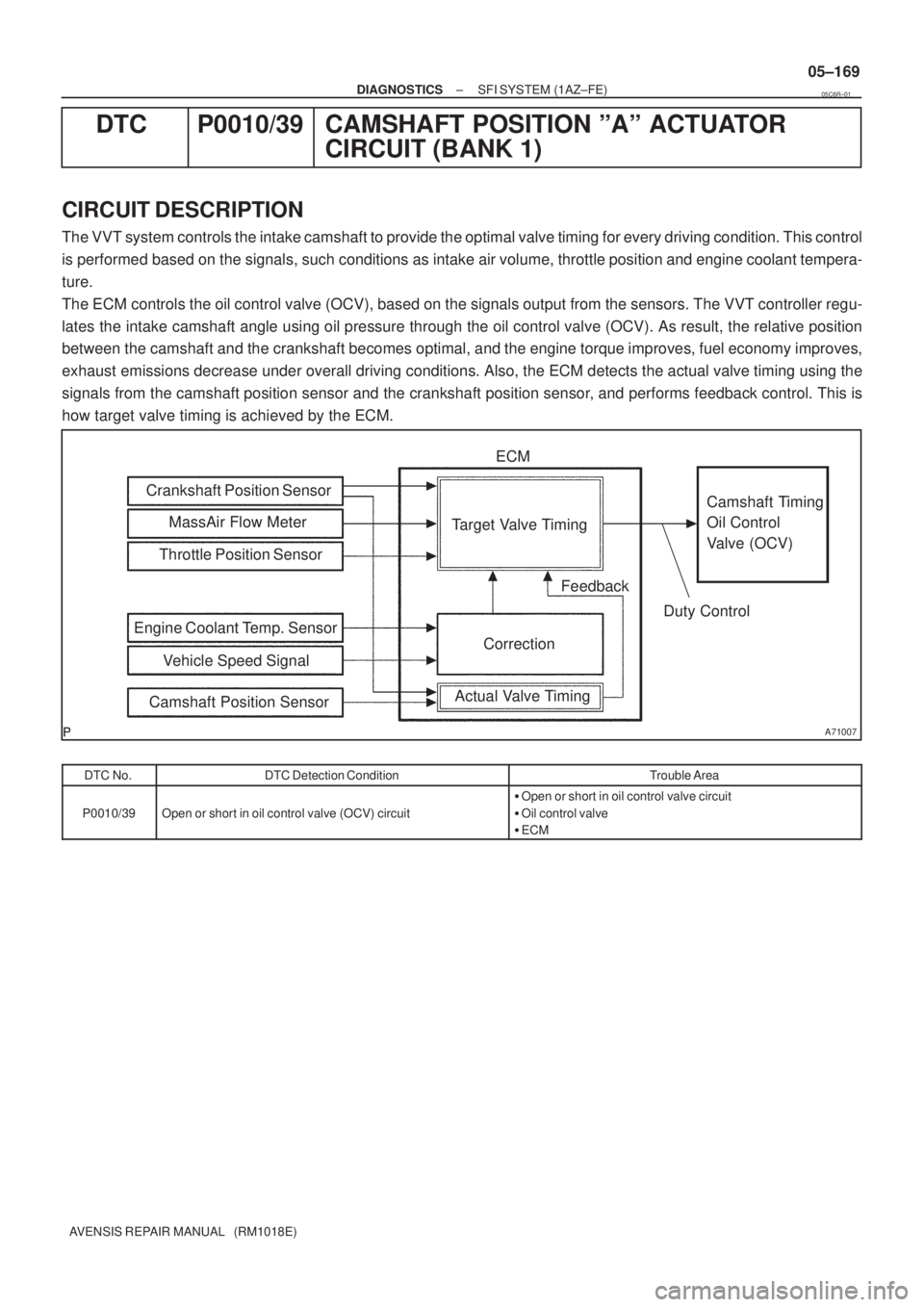
A71007
MassAir Flow Meter Crankshaft Position Sensor
Actual Valve TimingCorrection Target Valve Timing
Feedback
Duty Control ECM
Camshaft Timing
Oil Control
Valve (OCV)
Vehicle Speed Signal Engine Coolant Temp. SensorThrottle Position Sensor
Camshaft Position Sensor
± DIAGNOSTICSSFI SYSTEM (1AZ±FE)
05±169
AVENSIS REPAIR MANUAL (RM1018E)
DTC P0010/39 CAMSHAFT POSITION ºAº ACTUATOR
CIRCUIT (BANK 1)
CIRCUIT DESCRIPTION
The VVT system controls the intake camshaft to provide the optimal valve timing for every driving condition. This control
is performed based on the signals, such conditions as intake air volume, throttle position and engine coolant tempera-
ture.
The ECM controls the oil control valve (OCV), based on the signals output from the sensors. The VVT controller regu-
lates the intake camshaft angle using oil pressure through the oil control valve (OCV). As result, the relative position
between the camshaft and the crankshaft becomes optimal, and the engine torque improves, fuel economy improves,
exhaust emissions decrease under overall driving conditions. Also, the ECM detects the actual valve timing using the
signals from the camshaft position sensor and the crankshaft position sensor, and performs feedback control. This is
how target valve timing is achieved by the ECM.
DTC No.DTC Detection ConditionTrouble Area
P0010/39Open or short in oil control valve (OCV) circuit
�Open or short in oil control valve circuit
�Oil control valve
�ECM
05C6R±01